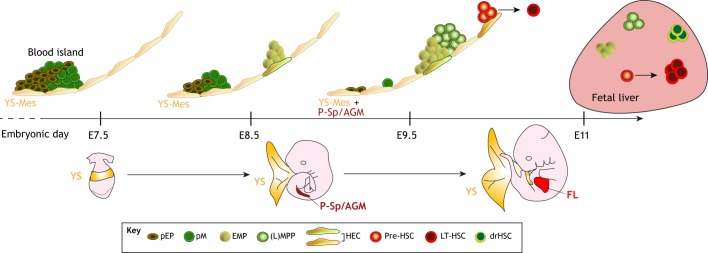Fig. 1.
A timeline of lineage emergence during mouse embryonic development. The first blood cells to emerge are primitive erythroid progenitors (pEPs) and primitive macrophages (pMs) in the blood island region of the yolk sac (YS) at ∼E7.5. Presumably, pEP and pM develop directly from the YS mesoderm (YS-Mes). At ∼E8.5-E10, erythro-myeloid progenitors (EMPs) and lymphoid (L)-primed multipotent progenitors (MPP) emerge in the YS and para-aortic splanchnopleura (P-Sp) and aorta-gonad-mesonephros (AGM), presumably from hemogenic endothelial cells (HECs). It is not known whether EMPs and (L)MPPs emerge from the same type of HEC, or whether different types of HECs give rise to different types of precursor cells. At ∼E10.5, the first long-term hematopoietic stem cell (LT-HSC) emerges from pre-HSCs, which develop from a specialized HEC (red outline) in the AGM. The cellular origin of the recently described developmentally restricted (dr)HSC is unknown. Green shades represent HSC-independent hematopoiesis; red shades represent HSC-dependent hematopoiesis. FL, fetal liver.

